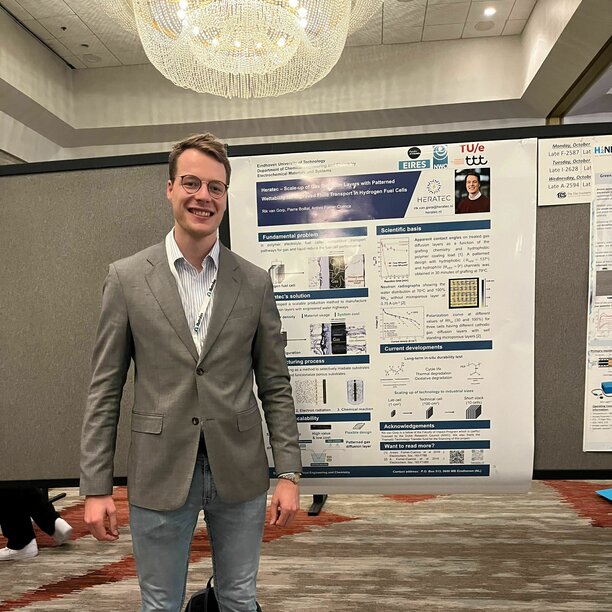Natural-born entrepreneurial engineer
Ever since he grew up, Rik van Gorp has been driven to make a positive impact on the way we live and on our balance with nature. As a fellow in the new, national Faculty of Impact program at TU/e he is working on the Heratec project that commercializes breakthrough electrodes for the next generation of electrochemical devices.
It is not very often that one comes across a person who is so determined in what he wants to do as Rik van Gorp is. That was already apparent when back in high school, he was looking for an academic training program. ‘It is a rather classic tale of the inspiring chemistry teacher who got me on the track towards studying chemistry,’ he says. He then deliberately chose to study both Chemistry and Chemical Engineering in Groningen, for two reasons. ‘First, Groningen is a renowned university when it comes to chemistry, with Nobel Prize winner Ben Feringa and other world class scientists working there. And second, Groningen offered me the possibility to combine ‘general’ chemistry with chemical engineering, which helped me determine which direction suits me best.’
During his bachelor studies, Van Gorp soon found out that it was the more industrial side of chemistry he found the most interesting. During his work as a member of a student team that promoted sustainable technology at primary schools, he came across the work of Hans Kuipers, Emiel Hensen, Kitty Nijmeijer and Martin van Sint Annaland at TU/e. That is when he decided that after obtaining his bachelor’s degree, he would switch to TU/e for his master program.
Gaining practical experience
At the end of his first year in Eindhoven, Van Gorp got to know Antoni Forner-Cuenca. ‘At that time, Toni primarily worked on redox flow batteries. I got intrigued and did my master’s end project under his supervision.’ In this project, Van Gorp developed a theoretical model for the optimization of porous electrodes for redox flow batteries. Afterwards, he also did an industrial internship at ITER, where he worked on tritium retention modelling. Van Gorp explains: ‘In a fusion reactor, deuterium and tritium melt together to form helium, neutrons and loads of energy. But the tritium itself is radioactive, with a half-life of about 12 years. The amount of tritium present in the reactor needs to be monitored at all time. I modelled how the tritium is deposited in Beryllium co-deposits onto the reactor wall and divertor, and how it can be retrieved most efficiently.’ During his time at ITER, the enthusiastic engineer discovered that he wanted to become an entrepreneur, and actively bring climate change mitigating solutions to the market. A technology previously developed by Antoni Forner-Cuenca to optimize gas diffusion layers for fuel cells was the perfect candidate for Van Gorp to start developing his entrepreneurial skills.
Novel material for fuel cells
‘The Heratec-project is based on a finding Toni did during his PhD studies at the Paul Scherrer Institute in Switzerland,’ Van Gorp says. ‘He developed a novel material that enables fuel cells to operate at a higher performance and in new configurations. Fuel cells basically consist of two separate compartments. In the one, hydrogen comes in. In the other, oxygen flows in and water flows out. Both compartments consist of a flow field, gas diffusion layer, microporous layer and catalyst layer and are separated by a membrane. The higher the performance, the more water is produced. The problem however is that the flows of water and oxygen are opposing and obstructing each other’s path. With our new radiation grafting method we can introduce highways through the gas diffusion layer that efficiently transport water and oxygen alongside each other, thereby increasing the achievable power density significantly.’
This so-called patterned wettability technique has been demonstrated at samples of one square centimeter. Within the Heratec-project, Van Gorp will scale up towards 25 square centimeters, and work together with industrial partners to showcase the technology in industrial systems. ‘Ultimately, for applications in fuel cells, we need dimensions of about 200 square centimeters. But with this first step we want to prove durability and robustness of the produced electrodes, and develop a production process that is able to reproducibly produce the material at the required scales,’ Van Gorp lays out his plans. In parallel to these lab experiments, he is also speaking to a myriad of potential users to learn about the market for this technology, and find out what conditions the product should meet in order to fit into the stringent product development pipeline of commercial parties.
Developing new skills
For a recently graduated chemical engineer, becoming an entrepreneur means entering unknown territory. In his endeavor, Van Gorp feels supported by multiple initiatives and people, he says. ‘The Heratec-project is support by Thematic Technology Transfer funds, which come with great assistance from TU/e and The Gate. And for me personally, my two-year fellowship from the Faculty of Impact is of great help. Through that initiative, I am learning what is needed when you want to start a new business, and I have access to a great group of like-minded souls who are all in the same position. On top of that, I am very happy to be affiliated with EIRES. I truly believe that through EIRES, the renewable energy ecosystem in Eindhoven can grow, learn and mature together.’ Though Heratec is not a start-up yet, it is Van Gorp’s strong ambition to one day be running his own business in the energy transition sector. ‘One way or the other, I want to bring the materials we so desperately need for the energy transition to the market as soon as possible and by doing so make a difference for the world.’
